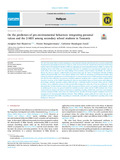On the predictors of pro-environmental behaviors: integrating personal values and the 2-MEV among secondary school students in Tanzania
Date
2022-05-03Author
Nkaizirwa, Josephat Paul
Nsanganwimana, Florien
Aurah, Catherine Musalagani
Metadata
Show full item recordAbstract
The role of personal values in understanding pro-environmental attitudes and behaviors has received considerable attention from psychological researchers. However, little is known about the mutual interaction of personal values and the Theory of Ecological Attitudes (2-MEV) in explaining pro-environmental behaviors (PEBs). To explore the mediating factors with which pro-environmental behaviors are explained via environmental attitudes and personal values, this article reports the study findings from secondary school students. Specifically, the article indicates the extent to which a unified model of personal values and the Theory of Ecological Attitudes (2-MEV) explain self-reported PEBs. The cross-cultural validity of the 2-MEV for measuring environmental attitudes (EA) among the selected respondents is as well investigated. A cross-sectional survey of 408 secondary school students was used for data collection. As expected, principal component analysis with a varimax rotation confirmed the two-factor structure of the 2-MEV measuring EA with two uncorrelated factors of Preservation and Utilization. Interestingly, multiple regression analyses indicated that a combined model of personal values and the 2-MEV provides a more explained variance of self-reported PEBs compared to when any of the two predicators is used independently. Overall, altruistic value provides the largest predictive power over egoistic and biospheric values in mediating EA. In turn, the general model that includes personal values and the 2-MEV indicates that Preservation makes the largest and unique contribution in explaining recycling, biodiversity protection, environmental activism, and general PEBs. Conversely, the Utilization factor provides the largest negative explained variance for management of environmental pollution behavior. These findings remain unaltered even when the age of respondents and social desirability responding are statistically controlled. The implications regarding these study findings are discussed.
URI
https://doi.org/10.1016/j.heliyon.2022.e09064https://www.sciencedirect.com/science/article/pii/S2405844022003528
http://ir-library.mmust.ac.ke:8080/xmlui/handle/123456789/2037
Collections
- Gold Collection [1026]

